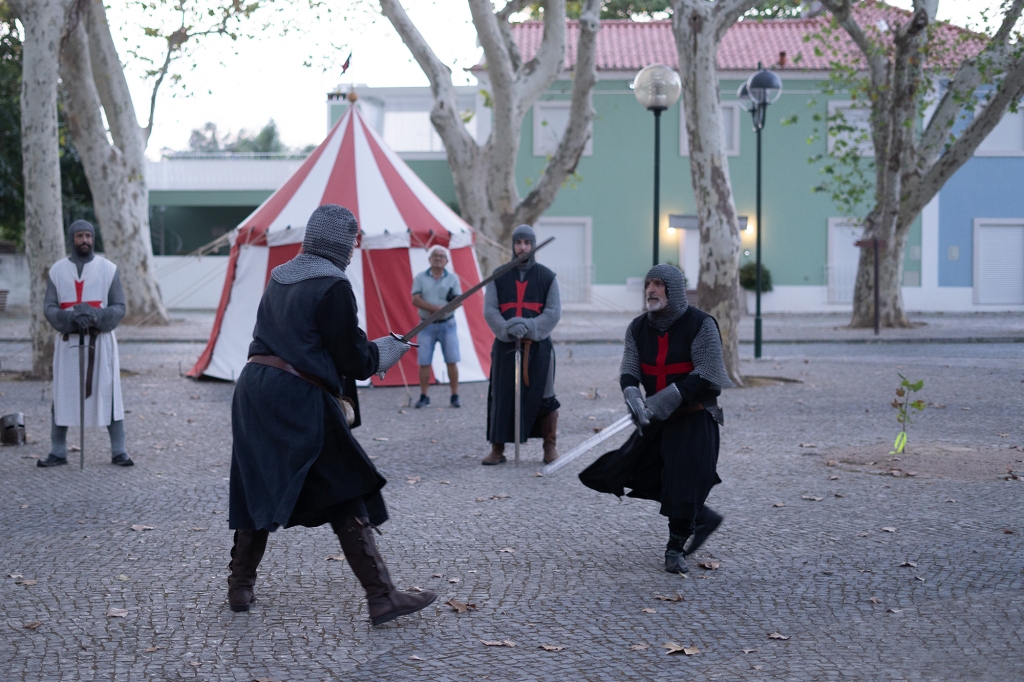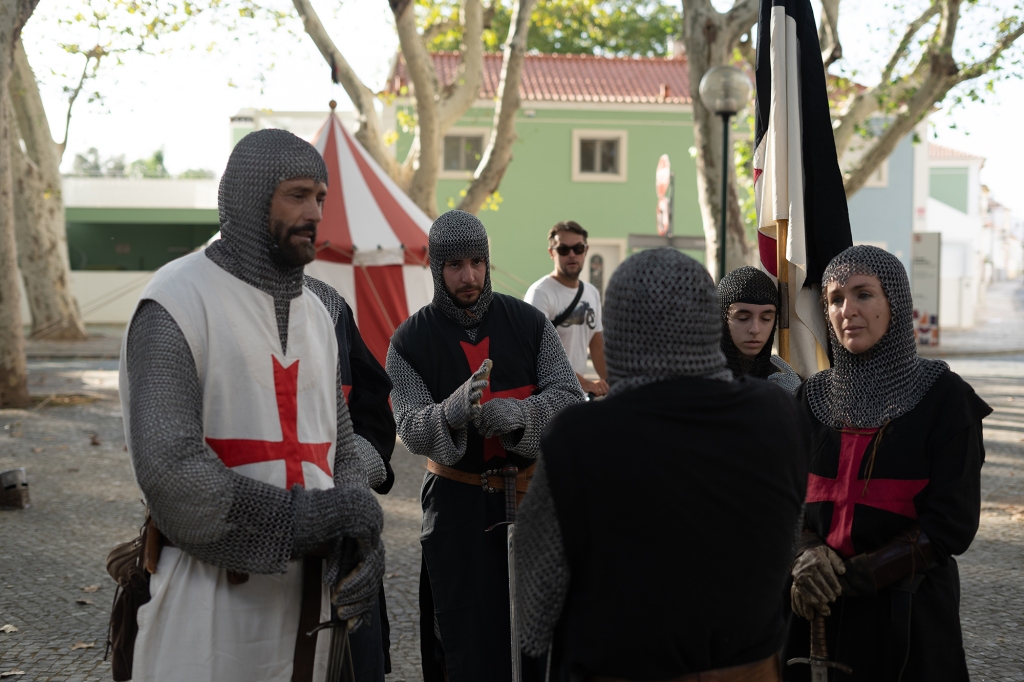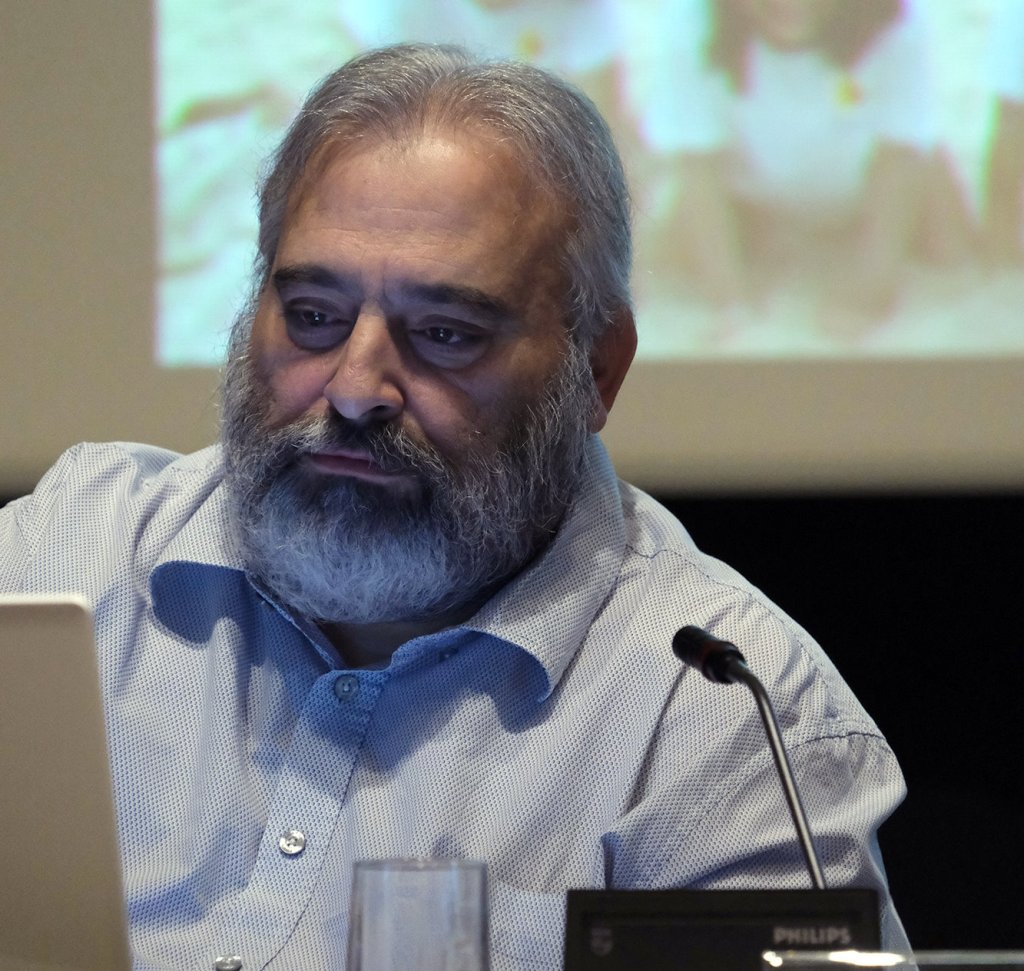Sigillum Templi
IV International Conference in Almourol

The weekend of the 13, 14 and 15 of October 2023, the Templar Interpretation Center of Almourol (CITA), Portugal, was host of the IV International Conference on Spiritual Chivalry, Templars and Templarism. For three days, scholars, specialists and the public were able to hear about new research on the Templars and debate a wide range of topics. Four new books were presented, including an expanded reprint of the original catalogue of the 2019 exhibition, that had since been out of print. The Conference is the largest and most prolific international Templar Event.

The Conference started on the evening of Friday 13, with the Mayor of Vila Nova da Barquinha, Fernando Freire, welcoming speakers, the public and members of the OSMTHU, whose Master, António Paris, attended the event. He remembered the date and the imprisonment of the Templars, adding that in 1195 Master Gualdim Pais died in Tomar on the 13 of October as well. Writer and Past CITA Curator Manuel J. Gandra, gave a brief presentation about the Conference and the topics to be discussed in the next couple of days, presenting the reprint of the first catalogue. Master Antonio Paris, who had flown from Rome to attend the event, spoke briefly about the importance of the event and the opportunity of cooperation presented by the fact that several branches of the Order today were invited to come to Almourol and share the knowledge and passion about Templar history and values. On midnight the Grand Priory of Portugal of the OSMTHU conducted a short, but evocative ceremony, in memory of the fallen Templars.
The proceedings started on Saturday, 14 with the presentation by Dom Nuno de Bourbon da Camara Pereira of a paper titled “The Saga of an Order of Chivalry of the 21st Century” about the recent history and court disputes of the Order of the Wing of Saint Michael. Founded in the 12th century by King Afonso Henriques, the Order was revived several times in history and had been in the center of a dispute between Dom Duarte Pio, head of the house of Braganza, and Dom Nuno Bourbon, founder of the last revival of the Order in 1981. The dispute was recently settled out of court, with the mediation of the Archbishop of Evora, resulting the the full reinstatement of rights to Dom Nuno as its Grand Master.

French writer and researcher Remy Boyer followed suit with “Figures of Perceval, archetype of the Knight”, a deep piece on the evolution of Perceval within the Quest, with all his adventures and challenges, a blueprint for Chivalric Initiation. The dichotomy between the Grail and the Spear was explained and the question of “who does the Grail serve?” that had to be formulated by Perceval once he saw both objects during the Fisher Kings banquet, pointed out as one of the symbolic keys of the Quest.
Heraldist David Fernandes da Silva spoke about “Catechesis and Confraternity, Examples and Thoughts”. He explained the role of catechesis as a source of testimony and the chain of tradition for the early communities, projected along the ages, giving some examples related to the Templars, including the “Non Nobis…” Psalm and the usage of the patée cross. He then explored the matter of the Templar brothers that were not professed but lived under the rule of the Order in Templar houses. To this level he called the “confraternity” as opposed to the “fraternity” of those who received the ordination.

After lunchtime the Templar Encampment was opened in the courtyard in front of the auditorium. For two days the Tomar Honoris group from Portugal and the Baucan group from Spain staged medieval reconstitutions that included dances, games and the reenactment of sword fight techniques.

The afternoon opened with João Pedro Silva, past Preceptor of the Portuguese Grand Priory, who gave a very detailed view of the procedures against the Templars in France, in his “The Templar Processus”. All the motivations by Philipp, the Fair and his dealings with Bertrand de Got (later Pope Clements V) were outlined. The subsequent fight for domination of the court proceedings between King and Pope, both wanting to be the ones spearheading the events, was explained. The account of the last days of the process and the eventual suspension of the Order was also detailed, giving the audience a vivid account of a subject that is usually wrapped in misinformation and attempts to oversimplify one of the most compelling court procedures of the middle ages.
The day finished with researcher and Associação Saudade’s VP, Virgílio Alves, and his “The Cathars in Portuguese Templar Territories”. In a long and detailed research paper, Virgílio Alves gave the audience the origins, context and history of the Crusade against the Albigensis in the 13th century, focusing then on the escaping Cathars and the help provided by the Order of the Temple, including in escorting a large number of “bons hommes” to the Portuguese region of Castelo Branco, logistical headquarters of the Portuguese Templars.

On the 14th, Sigillum Templi’s president Victor Padilla Nieto from Spain opened the proceedings with his “Tacuinum Sanitatis, and its influence on the Templar Order”. It was a presentation that exposed the influence of the Tacuinum Sanitatis, a set of ancient sanitary rules related to food preparation and health habits, that was fundamental for the Primitive Rule’s prescriptions on hygiene and food on the daily life of the Order.

Luis de Matos, International Chancellor of the OSMTHU, spoke next remembering a short passage of the letter of Bernard of Clairvaux to the Templars in which the military actions of the Order are justified by Christs own rage in the Temple (Mathew 23). He then expressed how that passage is also an inspiration when it comes to the state of Templarism in the world today, setting himself apart of the whole movement – that he said to be incapable of defending or representing. He concluded by stating that it’s increasingly difficult and alienating to be a traditionalist in Portugal, giving a few examples of how the authorities mishandle the administration of culture and old Templar monuments in the country.
The last leg of the Conference was opened by Bulgarian Professor Yuri Stoyanov, of SOAS University of London, who offered the paper “The Importance of Russian and Eastern European Museum and Archival Collections for Study of the Historical Knights Templar, Spiritual Chivalry and Templarism”. He traced the importance of many pre-war archival sources on Chivalry and Templarism that were scattered and disappeared after World Wars I and II. Many of these have since surfaced in Russia and Poland and hold critical information on subjects such as the 18th century Swedish (Templar) Rite of Freemasonry, the Order of Malta tradition in Saint Petersburg and the Templar Orders of the early 20 century in Russia.

The Conference was closed by researcher Manuel J. Gandra with his “Did the Templars Profess a Secret Doctrine? Thoughts on a Loaded Topic”. By dismissing right from the start the two main popular references to a secret doctrine in the Order: the Baphomet, the Statutes of Master Roncelinus, Gandra was able to concentrate on the several failed attempts made by revivals of the Order in the 18th and 19th century to be recognized the the Portuguese Order of Christ, as the sole legitimate pure lineage at the time. By studying archeological findings made at the Almourol Castle and architectural iconographic elements still visible in the Convent of Christ – including those of an hermetic and rosecroix background over 100 years older than the German Manifests – Gandra explored some of the canons of a doctrine that is visible and intelligible in Portuguese Templar sources, but unknown to the scholars still today.
Overall, the IV Conference was an absolute success. It was heavily attended, the communications were original, interesting and informative and the conversations that took place during the intervals show great promise for future projects about the Templars. Next year, put it on your calendar: 13 and 14 of October 2024 the destination is Vila Nova da Barquinha / Almourol, Portugal.
Pyeyros

Según la documentación medieval la aldea de “Pyeyros”, el actual lugar de Pieros (León), perteneció a la Orden del Temple, que tuvo allí numerosas propiedades rurales hasta el punto de llegar a constituir una encomienda aneja a la de Ponferrada, regida por el mismo comendador, que entre 1220-1224 fue frey Domingo Fernández y entre 1240-1249 frey Juan Fernández “el Viejo”. Se trataría de una granja fortificada, con capilla incluida dentro de las murallas, al estilo de Aberin (Navarra). Por desgracia todo ha desaparecido, únicamente resta la pequeña capilla originalmente obra del 1086 reconstruida en románico por el Temple. Hoy está irreconocible y lo único medianamente románico es su espadaña, con la pequeña portada oeste y algunos muros. Según es tradición las piedras de los edificios templarios se llevaron al vecino Monasterio de Carracedo, en el s.XVIII, para restaurar el templo de aquel cenobio, por eso hoy podemos ver en él numerosos sillares llenos de extraños signos: hexapétalas, rosáceas, poliskeles.
in Sigillum Templi, por Diego Wesley Nogueira
Templar Corps firma Protocolo con Sigillum Templi, principal club de Estudios Templarios de habla hispana

El Templar Corps International (templarcorps.org) ha firmado un protocolo con Sigillum Templi, el más grande e importante club de Estúdios Templários de habla hispana. La primera iniciativa conjunta es un Curso de estudio en la web en español sobre la Orden del Templo, que comienza el 25 de julio.
En una breve entrevista, Víctor Padilla Nieto, Administrador General, nos da una idea de lo que podemos esperar de esta colaboración.
TEMPLAR GLOBE:Victor, cuéntanos sobre Sigillum Temple, cuando a sido fundado y qué tipo de trabajo se ha publicado?
VICTOR PADILLA NIETO: Sigillum templo es un proyecto creado en el 2015 por un grupo multidisciplinar que estudia la Historia, principalmente en el período de vigencia de la orden del Temple.
Esto conlleva una serie de líneas de investigación para comprender y posteriormente divulgar el entorno de los Pobres Compañeros de Cristo y su herencia.

TG: ¿Cómo podemos unirnos a Sigilum Templi?
VPN: Tenemos diferentes vías de divulgación: Página de Facebook muy dinámica; Blog del medievo con más de 1500 entradas Onda Sigillum. Con un programa que investiga las Claves Ocultas de la Historia
Una web dónde poner en común las investigaciones y con una zona privada para socios.
TG: ¿Hay un boletín o revista para suscribirse?
VPN: Desde hace unos meses disponemos de dos tipos de publicaciones. Una digital y gratuita rllamada Cartularium templi, que se publica en PDF y se distribuye vía Facebook y en la web, y otra de pago por suscripción anual, el Codice Sigillum, impresa a todo color con unas 100 paginas. Escrita por los más prestigiosos articulistas y conocedores del medievo en general y de la Orden del Templo en particular.
TG: ¿Cuán importante es la historia de los templarios en el contexto de la Reconquista?
VPN: La importancia de la reconquista en la península Ibérica por parte de la orden del Temple es vital. No se puede concebir sin su ayuda a los diferentes reinos cristianos peninsulares. Mallorca, Valencia, Murcia, Sevilla, Algarve, entre otros muchos, son territorios ganados por el Temple a los diferentes reinos mencionados. Participaciones en la conquista de Calatrava la vieja y la inequívoca victoria en las Navas de Tolosa en las que las crónicas destacan a los caballeros templarios como los más aguerridos.
TG: ¿Qué motiva esta asociación con Templar Corps?
VPN: El principal motivo para esta asociación con Templar Corps es poder divulgar la historia sin dogmatismo. Templar Corps está avalada por un equipo de librepensadores que los diferencia con la mayoría de entidades con otros fines divulgativos más o menos dirigidos. Tanto Sigillum Templi como Templar Corps son entidades autosuficientes e independientes.
TG: ¿Qué puede esperar aprender un estudiante de este Curso?
VPN: En este curso los estudiantes van a tomar conciencia plena de la vital importancia de la Orden en la península Ibérica, y no solamente esto, sino que aprenderá el conocimiento esotérico básico para entender el por qué de muchas de las acciones que tuvieron y su significado.
TG: ¿La ciencia, el arte, la arquitectura, el conocimiento y la espiritualidad templaria son relevantes hoy en día o es solo un recordatorio nostálgico del pasado?
VPN: Por supuesto son importantes. Nada que ver con la nostalgia del pasado. La iconografía templaria revela al iniciado un camino al esoterismo. La geometría sagrada aplicada a las construcciones se ha puesto cada vez más en valor con la aplicación de nuevas tecnologías del siglo XXI . La organización de las encomiendas es un hito en el medievo. La alimentación está reglada y aplicada con nociones de dietética e higiene alimentaria… En resumen, la continuidad que da la orden del Temple a la Gran Tradición Ancestral, pone de manifiesto el enorme conocimiento que se transmite a todos y para todos.
Gracias Victor. Te deseamos lo mejor para el curso.
Puedes encontrar más información aquí:

Templar Corps Signs Protocol with Sigillum Templi, main Spanish speaking Templar study club

The Templar Corps International (templarcorps.org) – Academy has signed a Protocol with Sigillum Templi the largest and most important Spanish speaking Templar research club. The first joint initiative is an online Study Course in Spanish about the Order of the Temple, starting the 25th of July.
In a short interview, Victor Padilla Nieto, Administrador General, gives us an idea of what we can expect from this collaboration.
TEMPLAR GLOBE: Victor, tell us about Sigilum Templi, how old it is and what kind of research or investigation you have published?
VICTOR PADILLA NIETO: Sigillum temple is a project created in 2015 by a multidisciplinary group that
studies History, mainly in the period of the historical Order of the Temple. This involves a series of lines of research to understand and subsequently disclose the environment where the Poor Companions of Christ appeared and their heritage.

TG: How can we join Sigilum Templi?
VPN: We have different ways of making this work available: a very dynamic Facebook page , a Medieval blog with more than 1500 entries, a radio program program that investigates the Hidden Keys to History and a website where research can be shared and with a private area for members.
TG: Is there a bulletin or magazine to subscribe?
VPN: Yes. For a few months now we have had two types of publications. A free and digital one called Cartularium Templi, which is published in PDF and distributed via Facebook and the web, and another under annual subscription, the Codice Sigillum, printed in full color with about 100 pages, authored by the most prestigious columnists and connoisseurs of the Middle Ages in general and of the Order of the Temple in particular.
TG: How important is the history of the Templars in the context of the Reconquista?
VPN: The importance of the reconquest in the Iberian peninsula by the order of the Temple is vital. The different peninsular Christian kingdoms cannot be conceived without their help. Mallorca, Valencia, Murcia, Seville, Algarve, among many others, are territories won by the Temple to the different kingdoms mentioned. Their participation in the conquest of Calatrava the old and the unequivocal victory in the Navas de Tolosa in which the chronicles highlight the Knights Templar as the most fearless.
TG: What motivates this partnership with Templar Corps?
VPN: The main reason for this association with Templar Corps is to be able to spread the story without dogmatism. Templar Corps is endorsed by a team of freethinkers that differentiates them from most entities with other, more or less, purposes with an agenda. Both Sigillum Templi and the Templar Corps are self-sufficient and independent entities.
TG: What can a student of this Course expect to learn?
VPN: In this Course, students will become fully aware of the vital importance of the Order in the Iberian Peninsula, and not only this, but they will also learn basic esoteric knowledge to understand the reason for many of their actions and the meaning behind them.
TG: Are science, art, architecture, knowledge and Templar spirituality relevant today or is it just a nostalgic reminder of the past?
VPN: Of course they are important. Nothing to do with nostalgia for the past. Templar iconography reveals to the initiate a path to esotericism. The sacred geometry applied to constructions has been increasingly valued with the application of new technologies of the 21st century. The organization of the Commanderies is a milestone in the Middle Ages. Food is regulated and applied with notions of dietetics and food hygiene… In summary, the continuity that ensures that the Order of the Temple is part of the Great Ancestral Tradition, shows the enormous knowledge that has been transmitted to all and for all.
Thank you Victor. We wish you the best for the Course.
You can find more information here:

